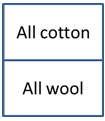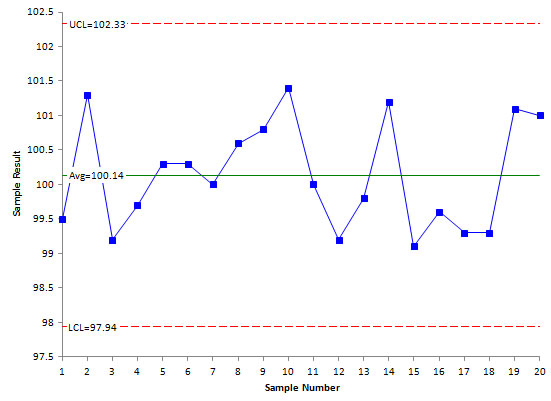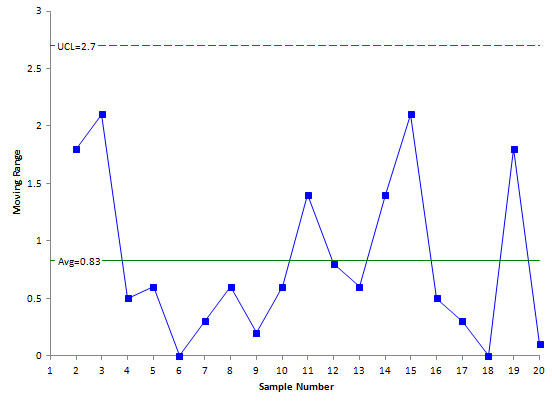May 2018
(Note: all the previous SPC Knowledge Base in the measurement systems analysis category are listed on the right-hand side. Select this link for information on the SPC for Excel software.)

What does it take for us to trust our measurement system?
Think about trust. Why do we trust some people? One reason is that they are consistent – we know what to expect from them because they are consistent. The same is true of our measurement systems. We begin to trust them once we know we are getting consistent results over time.
It is important to have measurement systems that are consistent. But what makes a measurement system consistent? This publication introduces an operational definition for a consistent measurement system developed by Dr. Donald Wheeler. In this issue:
- Operational Definitions
- The Operational Definition for Measurement Consistency
- Consistency Example
- Some Additional Insights into Measurement Consistency
- Summary
- Video: Consistent Measurement System
- Quick Links
You may download a pdf version of this publication at this link. Please feel free to leave a comment at the end of the publication.
Operational Definitions

Operational definitions are very important in many areas. Consider Pareto diagrams for example. Since Pareto diagrams are based on data, you must collect data. And quite often you are collecting qualitative data – reasons for picking errors, shipping errors, etc.
Maybe you are collecting data on supplier on-time performance to rate suppliers. What is on-time? On-time has many different definitions. Maybe it is the date we asked for it to arrive. If the supplier ships it early, is it on-time? If we agree to a change in the promised date, is it still on-time? On-time lacks a clear, operational definition.
What happens if you are collecting data with one interpretation of on-time and others are using a different definition? The data that are collected will be suspect and not much use to anyone. So, it is critical that you have good operational definitions so that everyone agrees when something, like on-time, occurs.
What are the elements of an operational definition? According to Dr. Deming, an operational definition has three elements that help you to apply it:
- Criteria: The standard against which to evaluate the results of the test.
- Test: A specific procedure for measuring a characteristic.
- Decision: The determination as to whether the test results show that the characteristic meets the criteria.
The following example is from Dr. Deming’s book. The question in the book is:
What means a label “50 per cent wool?”
The label on a blanket reads “50 percent wool.” What does that mean? One possible interpretation is shown in the figure below. It might be that one-half of the area of the blanket is wool and the other half is another material, such as cotton.
Is this your definition? Or is your definition that the wool is dispersed evenly throughout the blanket, as shown in the figure below.
There is nothing inherently right or wrong with these definitions. According to Dr. Deming – “You have the right and a duty to specify a definition that suits your purpose.” Suppose you decide it is the second definition. How can you develop an operational definition for this purpose? Again, there are three parts to an operational definition: criteria, test, and decision.
- Criteria: The criteria are that the wool and cotton fibers are evenly distributed throughout the blanket and the wool comprises half the total weight of the blanket. But what does this mean? The criteria are often tied directly to the test – as you would expect.
- Test: After you have decided on the criteria for “50 percent wool”, you must determine the test procedure to see if the blanket meets this criterion. This is the test in Dr. Deming’s example: Cut 10 holes in the blanket, 1 to 1.5 cm in diameter, centered by random numbers. Number the holes from 1 to 10. Hand these 10 pieces to a chemist for a test. He will follow prescribed rules. Ask him to record xi, the proportion wool by weight for hole i. Compute x, the average of the 10 proportions. The following are the criteria:
x ≥ 0.50″
xmax– xmin≤ 0.02
- Decision: If the average of the 10 samples is greater than or equal to 0.50 and the difference between the maximum wool content and minimum wool content is less than or equal to 0.02, then the blanket meets the specification. If the sample fails either one of the criteria, the blanket fails to meet the specification. This is a yes/no decision – did the test result meet the criteria.

Operational definitions are also only relevant in the particular circumstances you are examining. Dr. Deming asked:
What is a clean table?
Well, it depends on what the table is going to be used for. If it is your workbench, then clean is probably just clear of tools and clutter. If it is your dining table, you probably want it to be a little cleaner than your workbench. And if it is the table on which your surgeon will perform your operation, you want it to be clean very well – using everything you can to kill germs. The operational definition for a “clean” table in each of these circumstances will be different.
The Operational Definition for Measurement Consistency
Dr. Donald Wheeler laid out the operational definition for a consistent measurement system in his excellent book EMP III Evaluating the Measurement Process & Using Imperfect Data, SPC Press (www.spcpress.com). And, not surprising since it is Dr. Wheeler, that operational definition includes the use of control charts to judge the measurement process behavior over time.

-
- Criteria: The standard against which to evaluate the results of the test.
A measurement system “is consistent if and only if repeated measurements of the same items result in a sequence of values that are homogeneous.”
-
- Test: A specific procedure for measuring a characteristic.
An individuals control chart is used to determine if the values are homogeneous, i.e., in statistical control. The individual values for the repeated measurements are plotted on the X (individual chart) and the moving ranges between consecutive points are plotted on the moving range chart. The averages and control limits are calculated using the formulas for the individuals control chart.
-
- Decision: The determination as to whether the test results show that the characteristic meets the criteria.
The measurement process is consistent as long as no points are beyond the control limits, there are no patterns (such as eight points in a row above the average), and the control limits are based on a least 10 degrees of freedom. The measurement process is inconsistent if there are points beyond the control limits or there are patterns present.
Consistency Example
One operator measures the same sample 20 times. The results are given in Table 1.
Table 1: Repeated Measurements of the Same Sample
| Number | Result | Number | Result | |
|---|---|---|---|---|
| 1 | 99.5 | 11 | 100 | |
| 2 | 101.3 | 12 | 99.2 | |
| 3 | 99.2 | 13 | 99.8 | |
| 4 | 99.7 | 14 | 101.2 | |
| 5 | 100.3 | 15 | 99.1 | |
| 6 | 100.3 | 16 | 99.6 | |
| 7 | 100 | 17 | 99.3 | |
| 8 | 100.6 | 18 | 99.3 | |
| 9 | 100.8 | 19 | 101.1 | |
| 10 | 101.4 | 20 | 101 |
The results in Table 1 were analyzed using an individuals control chart. The X chart is shown in Figure 1.
Figure 1: X Control Chart for Repeated Measurements of the Same Sample
Each individual result is plotted on the X control chart. The purpose of this control chart is to determine if the results are consistent. As long as there are no out of control points, the measurement process is consistent with respect to the average. There are no out of control points, so the X control chart is consistent (in statistical control).
Figure 2 is the moving range chart for the data in Table 1. The moving range chart plots the moving range between consecutive results. There are two purposes to this control chart. One is to determine if the moving range between consecutive results is consistent over time. The second is to estimate the standard deviation of the measurement system.
Figure 2: Moving Range Chart for Repeated Measurements of the Same Sample
As long as there are no out of control points, the moving range is consistent (in statistical control). This is true for the control chart in Figure 2.
Since both the X and mR control chart are stable, then the measurement process is consistent. If there had been any out of control points, then the measurement process would not be consistent.
So, is this the end of the story? The measurement system is consistent, and you are done? Not quite. There are a few other items to consider as shown below.
Some Additional Insights into Measurement Consistency
The control chart above can continue to be used to monitor your measurement process consistency over time. This allows you to continually monitor the stability and to find and eliminate special causes of variation when they occur.

What do you do when your consistency chart has an out of control point? The temptation may be to assume that you simply need to recalibrate. That is not necessarily true. You should work to find and eliminate the special cause of variation that occur.
OK – your measurement system is consistent. The control chart looks great. Are you done? No, not yet. Bringing the measurement system into statistical control is simply putting it where it is supposed to be. The next question to be answered is
Is my measurement system good enough?
Seems like we might need another operational definition. Most people consider the % of total process variance that is due to the measurement system and then use an arbitrary rating system to see if the measurement process is “good enough.” For example, a measurement system is acceptable if the % of variance due to the measurement system is between 1 and 9%. This is not the best way to determine how good your measurement system is. By the way, this is where you calculate the standard deviation of the measurement system – the second use of the moving range chart.
Dr. Wheeler has developed a process for determining how good a measurement process is. It is in his book referenced above. Instead of using arbitrary numbers as above, he applied his knowledge of how measurement error impacts a process. Based on this, he classifies a measurement process as a First, Second, Third, or Fourth class monitor. These four classes give you insight into these three characteristics of the measurement system:
- How the measurement system can reduce the strength of a signal (out of control point) on a control chart.
- The chance of the measurement system detecting a large shift.
- The ability of the measurement system to track process improvements.
The key is that you are not done once the measurement system is consistent. For more information on Dr. Wheeler’s system, please see our earlier publication.
Summary
This publication has examined the operational definition for a consistent measurement system. It begins by reviewing Dr. Deming’s explanation of operational definitions. Then, Dr. Wheeler’s operational definition of a consistent measurement system was introduced. It is important to ensure that a measurement system is consistent over time. However, the work is not totally done once your measurement system is consistent. You still must answer the question of how good a measurement system is.



